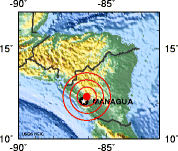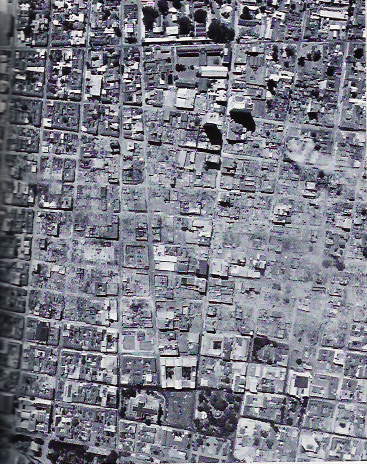- 1972 Nicaragua earthquake
Earthquake
title=1972 Nicaragua earthquake
date=December 23 ,1972 

magnitude = 6.2 Mw
depth=convert|5|km|mi|0
location=
countries affected = NIC
tsunami = none
casualties = 5,000The 1972 Nicaragua earthquake refers to theearthquake that occurred at 12:29 a.m. (local time) on Saturday,December 23 ,1972 inManagua , the capital ofNicaragua . With a magnitude of 6.2, it occurred at a depth of about 5 kilometers beneath the center of the city. Within an hour after the main shock, two aftershocks, one of magnitude 5.0 and the other 5.2, occurred [ [http://earthquake.usgs.gov/regional/world/events/1972_12_23.php Earthquake Hazards Program]USGS , Retrieved onJune 2 2008 ] . The earthquake caused widespread damage and approximately 5,000 of the 400,000 population of Managua were killed, leaving 20,000 injured and over 250,000 homeless.Tectonics and background
Managua city, which lies on the southern shore of
Lake Managua near the western coast of Nicaragua is situated within an active volcanic zone known as the Central American Volcanic Chain. The city has a long history of volcanic and seismic activity which arises from the relative movements of two crustal plates which intersect near the southwestern border of Central America. TheCocos plate, located east of theEast Pacific Rise , is moving northeastward and is slowly being submerged under the Caribbean plate. The zone of dipping is initiated at the surface of the Middle American Trench, which extends 4 to 5 kilometers deep along the Pacific Coast fromMexico toCosta Rica [Earthquake Information Bulletin, September-October 1973, Volume 5, Number 5., Retrieved onJune 2 2008 ] . But rather than a simple crustal movement between the two plates the earthquake was believed to have been caused by a shallow adjustment to geological pressure at the south western corner of the Caribbean plate.One of the most significant effects geologically of the 1972 Nicaragua earthquake quake was surface faulting. Examination of the fault lines indicated a lateral motion moving in a northeasterly direction and aftershock data has revealed at last one of the faults extends from the surface to a depth of 8 to 10 kilometers beneath the city of Managua.
tructural effects
The earthquake severely damaged an area of 27 square kilometers and destroyed 13 square kilometers in the city centre. The majority of the buildings in the central business district sustained significant structural damage including a 17-story building, one 15-story building, approximately 5 buildings in the 7 to 9 story range and well over 25 buildings in the 3 to 6 story range. Much of the damage arose from seismic ground movement which occurred within 10-15 seconds of the main shock. The majority of the factories and smaller buildings were severely damaged. Many of the houses and small shops were over 40 years old and constructed in a
taquezal architectural style construction with weak wooden beam construction withadobe or stone plaster. With the erosion resulting from their age, it rendered the buildings defenceless. An estimated 53,000 homes in the city were affected. [ [http://earthquake.usgs.gov/regional/world/events/1972_12_23.php Earthquake Hazards Program]USGS , Retrieved onJune 2 2008 ]The water and electrical power network was affected to the extent that even a week following the earthquake only 10% of the city had any working water service.
Response
Two-thirds of Managua's 325,000 residents were displaced and faced famine and disease and dry-season winds worsened the problem with fires created by the disaster. [Earthquake Information Bulletin, September-October 1973, Volume 5, Number 5., Retrieved on
June 2 2008 ] Due to the damaging effects of the earthquake many of the emergency services in the city were operating at a seriously lower level than normal. The earthquake destroyed all the fire-fighting equipment available and fires were prevalent in some areas for several days. All four main hospitals which before the disaster had 1650 beds were unserviceable.The Nicaraguan government appealed for aid, and the government accepted aid from countries like theUnited States andMexico and some 25 other countries worth millions of dollars. Despite this and the magnitude of the devastation, the aid was not distributed well and the rulingLiberal-Conservative Junta was the target of criticism and was accused of stockpiling foreign aid which never reached the victims of the earthquake. [citeweb|url=http://news.bbc.co.uk/onthisday/low/dates/stories/december/23/newsid_2540000/2540045.stm
title=1972: Earthquake wreaks devastation in Nicaragua|accessdate=2008-06-02|publisher="BBC "] It was due to these reports that the American baseball starRoberto Clemente chose to accompany the fourth relief flight he organised. That flight crashed on December 31, 1972 killing Clemente among others.Due to the extent of the damage, the Managua city centre was never rebuilt, but has evolved into an array of loose markets and businesses located with small parks and squares.
According to Mark Schneider, deputy administrator for Latin America of the
U.S. Agency for International Development , speaking in the aftermath ofHurricane Mitch in November 1998, the earthquake, "destroyed the center of the entire city and forced a redesign of development in Nicaragua." [citeweb|url=http://www.latinamericanstudies.org/nicaragua/earthquake.htm|title= One disaster recalls another: 1972 earthquake's effects still felt|accessdate=2008-06-02|author=Don Bohning|date=November 3 ,1998 |publisher="The Miami Herald "]References
Wikimedia Foundation. 2010.
